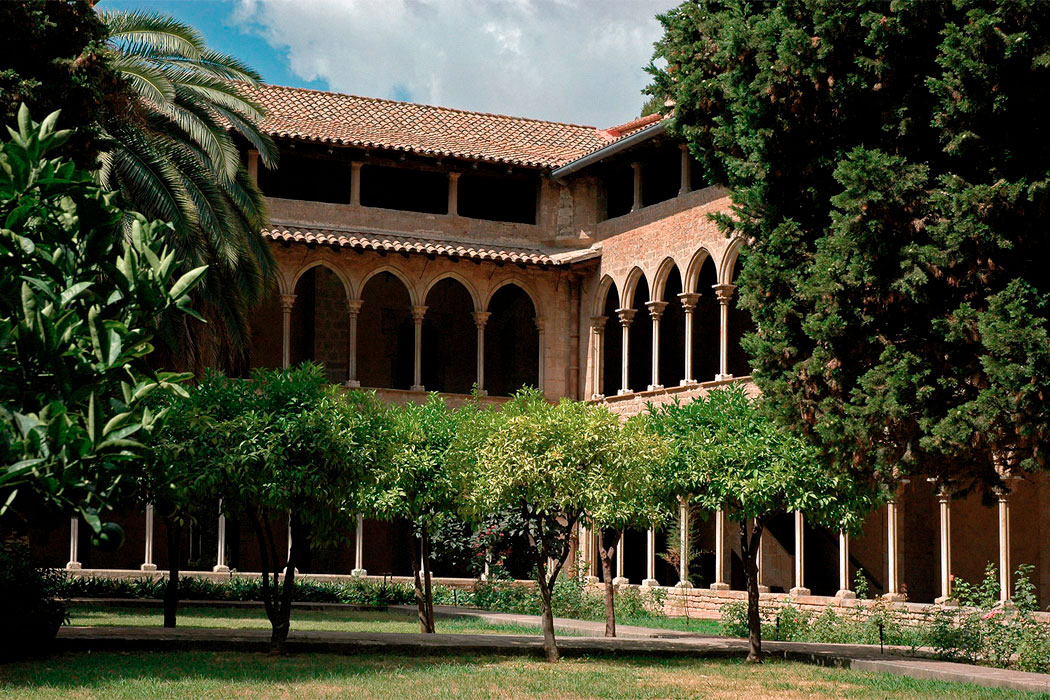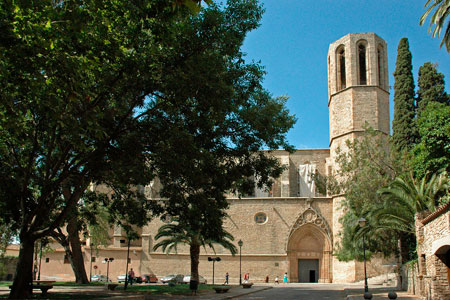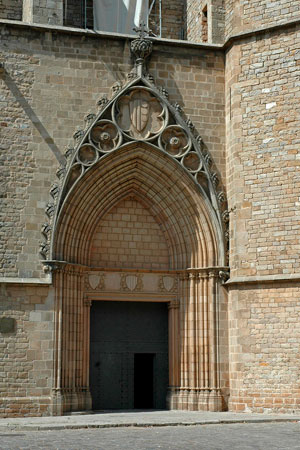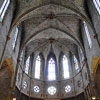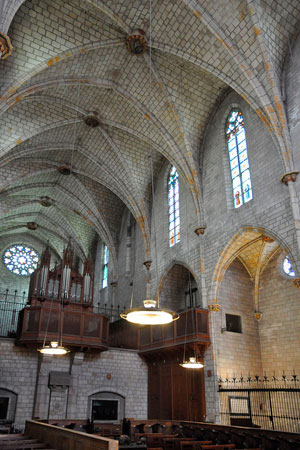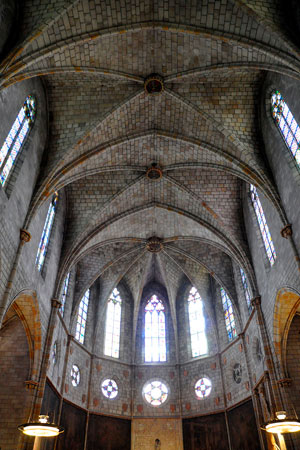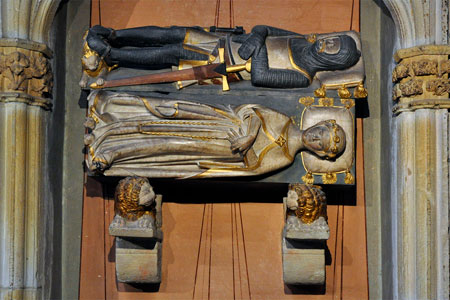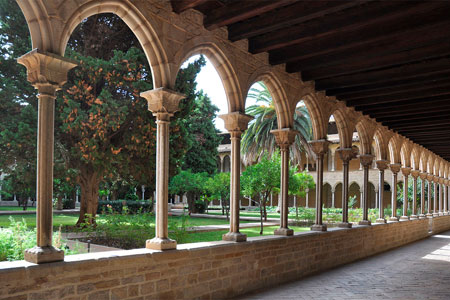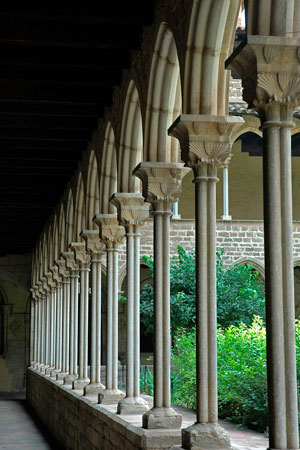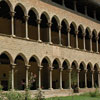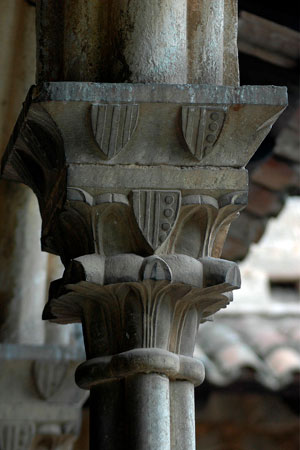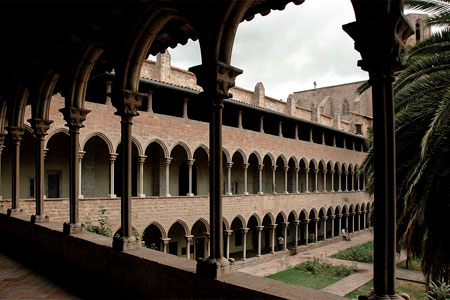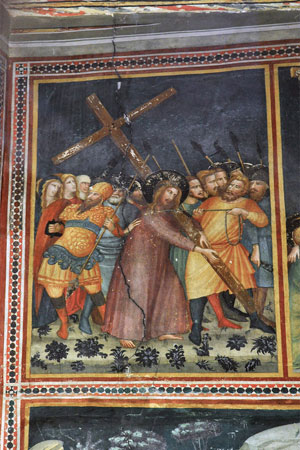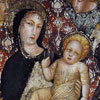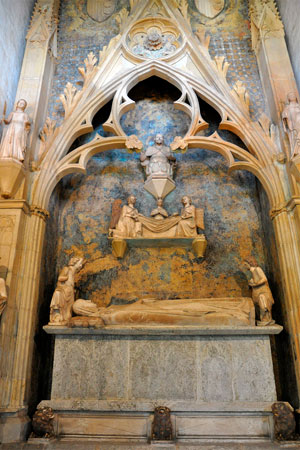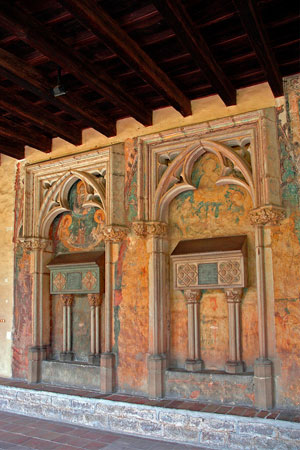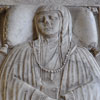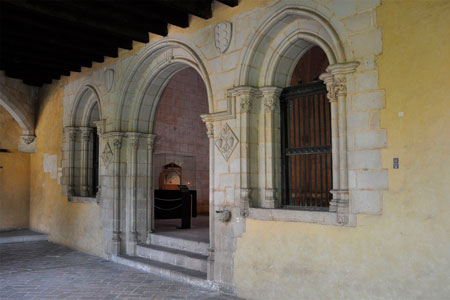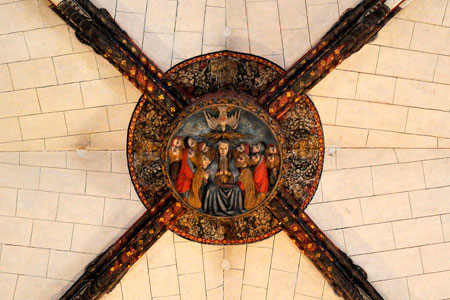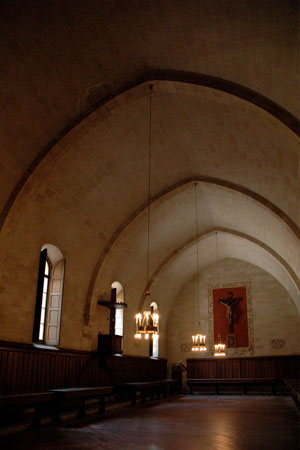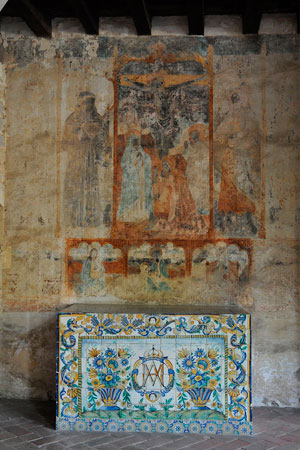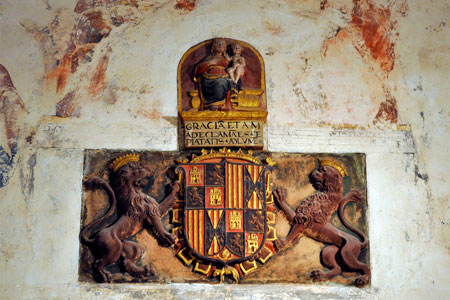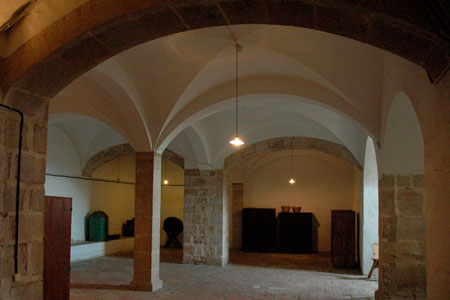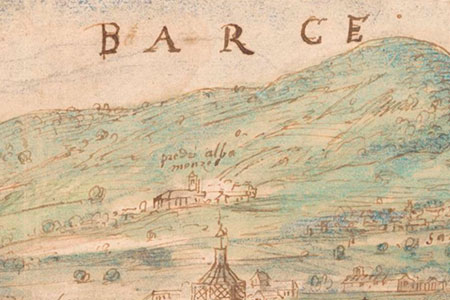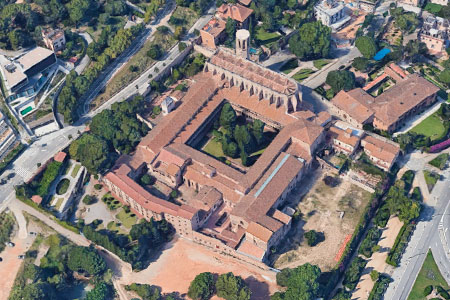Monastery of Pedralbes
Monestir de Santa Maria de Pedralbes / Sancta Maria de Petra Alba
The monastery of Pedralbes was created with the intervention of Queen Elisenda de Montcada (c1292-1364), wife of James II of Aragon, who in 1322 had already expressed her wish to found a Poor Clare monastery. The project began by obtaining the appropriate licence from Pope John XXII, then the donation of an estate in Valldaura was made, but in 1326 Elisenda herself acquired some land in Pedralbes, where the monastery now stands. The change was probably made to provide more security for the community in a place that, despite being far from the city, was close to Sarrià and not so isolated.
The first stone was laid that same year and in 1327 it was inaugurated. Although it was not finished, the place was habitable within a year and the space available for the first community, which was made up of fourteen nuns from the monastery of Sant Antoni and Santa Clara in Barcelona. At the end of 1327 the queen was widowed and at the beginning of 1328 she retired to the monastery she had founded, where she had a private residence, or palace. From here she continued to regulate and protect the place, with provisions and donations in her favour. She died in the monastery years later, in 1364, where she was buried. By then the community numbered forty nuns. The queen had granted a will in favour of the monastery, which consolidated her good financial position.
As time went by, the monastery gained prestige, influence and economic power, largely thanks to the protection of the noble houses that intervened in the monastic project with the entry of their daughters into the community, without forgetting the other powerful organisms, the royal house and the city of Barcelona. From the 16th century onwards, the influence of the powers of Castile increased at the same time as customs were reformed in accordance with the new times. As the years went by, the house gradually lost its prominence and economic power.
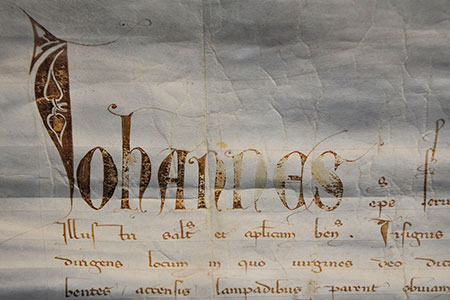
granted by Pope John XXII (February 1, 1325)
Monastery Archive
With the Peninsular War, the community had to abandon the enclosure on some occasions, while on others it also served as a refuge for nuns from various communities who had been expelled from their convents in the city. In 1835, with the confiscations of Mendizábal, the monastery was closed, but the nuns were able to return quickly (1838). Unlike other communities, these removals from the monastery did not mean any notable loss of movable heritage. The turn of the century was marked by the presence of Eulalia Anzizu (1868-1916) within the community, who gave new impetus to the monastery.
Part of the old buildings can be visited as a museum belonging to Barcelona City Council, while the community moved to new premises next to the old monastery. In February 2025, the last nuns moved to Viloví d'Onyar (Selva). Due to its rapid construction, the monastery retains a great deal of unity, although ‘minor’ works were carried out in later periods. Previously, the monastery complex was much larger and included other buildings that later passed into private hands, as well as its own spaces that are now public and open, such as the Monastery Square.
The cloister dates from the first period of construction. In a second stage (1415-1419) the chapter house was built (probably a renovation of an earlier construction) and the first floor of the cloister. Next to the Poor Clare monastery, a convent of Franciscan friars was established for their service. Their task was to attend to the nuns spiritually, as well as to pray for the founders. The place they occupied is known as ‘el Conventet’. One of the latest interventions has been the refurbishment of the former dormitory and part of the queen's palace as an exhibition room for various works from the Thyssen-Bornemisza collection, which were later moved to the MNAC (Museu Nacional d'Art de Catalunya) and are now occupied by the monastery museum.
The mural painting of the Chapel of Sant Miquel
The mural decoration of the Chapel of Saint Michael, which opens onto the cloister, was commissioned between the Abbess Francesca de Saportella and the painter Ferrer Bassa. The work was carried out between 1343 and 1346, and it depicts scenes from the Joys of the Virgin and the Passion, as well as isolated figures of various characters.
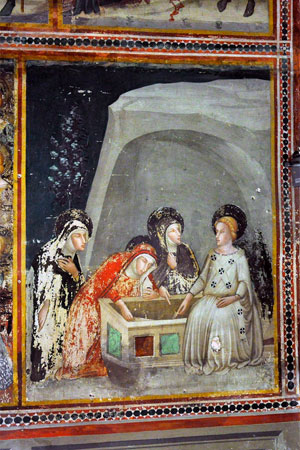
The Three Maries in the Sepulchre
The tomb of Elisenda de Montcada
The sepulchre of the founder of the monastery has the peculiarity of being double; that is, with a face that gives the church and a second in the cloister. They are very similar, only that the jacent statue of the church represents her as queen, while in the face of the cloister it is seen with the habit of Poor Clare. According to what is manifested in the will of the deceased, the work was already completed in 1364, when she died.
- AINAUD DE LASARTE, Joan; MUNDÓ, Anscari M. (1997). Els vitralls de la catedral de Barcelona i del monestir de Pedralbes. Barcelona: Institut d’Estudis Catalans
- AIXALÀ, Carme; Ramos, Jordi (2014). Monestir de Pedralbes. República, guerra i patrimoni. Barcelona: Monestir de Pedralbes
- ALCOY I PEDRÓS, Rosa (2005). Ferrer Bassa, un creador d’estil. L'art gòtic a Catalunya. Pintura I. De l’inici a l’italianisme. Barcelona: Enciclopèdia Catalana
- ANZIZU, Sor Eulària (1897). Fulles històriques del Real Monestir de Pedralbes. Barcelona: F. Xavier Altés
- BALASCH, Esther; ESPAÑOL, Francesca; ed. (1997). Elisenda de Montcada. Una reina lleidatana i la fundació del Reial Monestir de Pedralbes. Lleida: Amics de la Seu Vella
- BASSEGODA, Buenaventura (1928). Pedralbes. El convento. Notas de historia y de arte. Barcelona: J. Thomas
- BESERAN, Pere; CUBELES, Albert; LUJIÀ, Josep M. Julià (2002). El convent de Santa Maria de Pdralbes. L’art gòtic a Catalunya. Arquitectura I. Barcelona: Enciclopèdia Catalana
- CASTELLANO, Anna (1994). Las clarisas en la Barcelona del siglo XIV. El ejemplo del monasterio de Santa Maria de Pedralbes. Notas para su historia. Las clarisas en España y Portugal. Actas II/2. Madrid: Archivos e Historia
- CASTELLANO, Anna (1998). Pedralbes a l'edat mitjana. Història d'un monestir femení. Barcelona: Publicacions de l'Abadia de Montserrat
- CASTELLANO, Anna (2014). El projecte fundacional del monestir de Santa Maria de Pedralbes i el palau de la reina Elisenda de Montcada a través de dos inventaris del 1364. Anuario de estudios medievales, núm. 44/1
- CASTELLANO, Anna; i altres (2005). Pedralbes, els tresors del monestir. Ajuntament de Barcelona
- ESCUDERO, Assumpta; i altres (1976). El moble català al monestir de Pedralbes. Ajuntament de Barcelona
- ESPAÑOL, Francesca (2014). L’univers d’Elisenda de Montcada i el seu patronatge sobre el monestir de Pedralbes. Lambard. Estudis d’art medieval, vol. 25
- GAVÍN, Josep M. (1997). Inventari d'esglésies. Vol. 28. Barcelonès IV (Barcelona Capital III). Barcelona: Arxiu Gavín
- GONZÁLEZ, Reinald (2023). Tot redescobrint Pedralbes. Apunts sobre els orígens arquitectònics i constructius del monestir de Santa Maria de Pedralbes de Barcelona. Els monestirs en època medieval i moderna. Novetats des de l’arqueologia. Universitat de Girona
- MESTRES, José O. (1882). Real Monasterio de Santa María de Pedralbes. Apuntes histórico-arquitectónicos. Barcelona: C. Verdaguer
- MONREAL, Luis (1971). El Conventet. I Història de una casa en Pedralbes. Barcelona: F. Godia
- PLANXATS, Clara de Jesús (1994). El archivo medieval del real monasterio de madres clarisas de Santa María de Pedralbes (Barcelona) y Sor Eulalia Anzizu. Las clarisas en España y Portugal. Actas II/1. Madrid: Archivos e Historia
- SANAHUJA, Pedro (1959). Historia de la seráfica provincia de Cataluña. Barcelona: Ed. Seráfica
- SANTJUST I LATORRE, Cristina (2008). L'obra del Reial Monestir de Santa Maria de Pedralbes des de la seva fundació fins el segle XVI. Tesi doctoral. Universitat Autònoma de Barcelona
- TRENS, Manuel (1951). Pedralbes y sus pinturas. Barcelona: S. Cots
- VIVES I MIRET, J. (1964). El monestir de Pedralbes. Assaig sobre la identificació del seu constructor. Barcelona: Vives i Miret
- Link ↗ : Claustra
- Link ↗ : Reial Monestir de Santa Maria de Pedralbes
